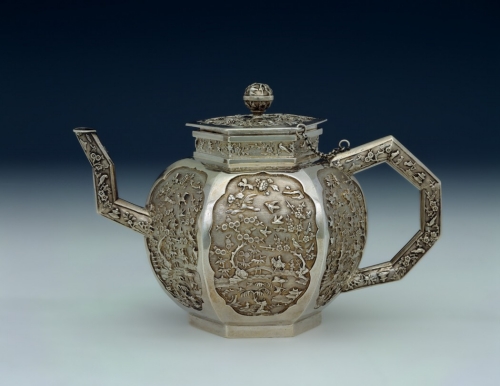The antiquarian manual Old English Plate was the first art-historical study of English silverware. In the 1899 edition, W. J. Cripps wrote that the “earliest [English] tea-pot known to the author in actual domestic use” was a hexagonal pot with a full set of English hallmarks, including the date mark for 1682/1683. Its identification remained unchanged until the 1970s, when the teapot was published in the catalogue Chinese Export Silver; due to scientific analysis of its alloy, it was reattributed as the work of an early Qing Chinese silversmithing workshop. The teapot is now understood as an exceedingly rare, datable artifact made by late 17th-century Chinese goldsmiths, and its hallmarks are viewed as evidence that it was imported, assayed, and then retailed according to English law. However, to date, it has not been included in any history of Chinese gold and silverwares. In other words, the teapot has never been viewed as a “Chinese original.” No longer English, not quite Chinese, the teapot is a liminal object from a disciplinary standpoint.
It is thus symptomatic of the paradoxical status of silver in Qing China, the central concern of this dissertation: in scholarship, silver is simultaneously pervasive as a monetary material and almost completely overlooked as a crafted object. Silver was the very material of global capital in the early modern world. It has been called a near-universal standard of value and medium of exchange, particularly in the form of pesos mined, refined, and struck in the Spanish colonial Americas. Millions of American dollars were transshipped to Ming and Qing China by European and American trading companies and firms, where they circulated as commodity money and were re-smelted into ingots for taxes, trade, and military salaries. Yet it is precisely due to silver’s close association with money that it was considered a politically and morally compromised craft material in late imperial China, leading to asymmetries in the study and preservation of wrought wares. The subjects of this study are the silver and silverwares that become newly visible, tangible, and contestable in circulation between Qing Chinese agents and their Anglo-European trading partners.
My year of residency at the Center, spent abroad in Taipei, has given me the time to deeply consider questions raised by my fieldwork in Asia, Europe, and North America. Across four chapters, I examine silver objects—both coined and wrought—at their points of cross-cultural transaction. How was silver ranked, moralized, typologized, and narrativized—in other words, viewed as a social and political, rather than just economic, medium? The first two chapters of my dissertation address the problem of transmission in the late 17th and 18th centuries, uncovering the root of relative consumption across contexts. The first chapter uses the surface ornament and marks on the 1682/1683 silver teapot to ask what craft, and the stories told about it, can impart about its Chinese maker. The second chapter puts the teapot into a longer object lineage, one that spans its transmission to Europe. It traces the hierarchical positioning of precious metal vessels in Chinese and European texts on tea, taste, and trade to track why it was apparent to late 17th-century commentators that the Chinese preferred to drink their tea out of ceramics, and Europeans out of metals.
The last two chapters move to the first half of the 19th century, by which time a formalized trading system at Guangzhou provided for residency of foreign sojourners, as well as the growth of a Chinese silversmithing industry catering to that market. Silver’s “inherent” value, as measured in the percentage of precious metal in its alloy, is invisible to the human eye, and the metal is at high risk of debasement and other attempts at counterfeiting. To make its value legible for ease of transaction, specific forms, surface ornament, and impressed marks grant objects legitimacy in the marketplace. But considering the mutability of silver, how might the reliability of such signs and shapes be judged, especially in situations of long-distance, cross-cultural trade? In the third chapter, I reconstruct the port-based systems through which Chinese merchants and others assessed silver coins in European forms; and in the final chapter, I do the same for the Chinese silverwares in European shapes made for Euro-American sojourners. Hierarchies of value pinned to form are necessary for making ambivalent objects legible, whether as objects of value or objects of knowledge.
[University of California, Berkeley]
Andrew W. Mellon Fellow, 2019–2021
Susan Eberhard will return to the University of California, Berkeley, for the fall 2021 semester to finish her dissertation.

